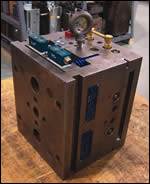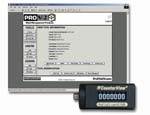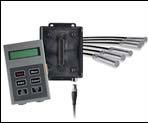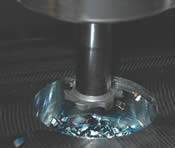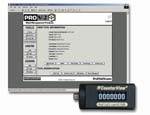Automated In-Mold Marking for Plastic Injection Mold Tools
The importance of plastic part traceability and how to achieve it.
Traceability and accountability have become increasingly important to molders and end users. The demand for quality parts delivered in a timely manner is more critical than ever now that finished parts may end up at several different locations—potentially all over the globe. When parts need to fill a pipeline of distribution outlets it can become a nightmare determining which part ended up where. If by chance there’s an engineering change or recall situation, those responsible for the parts need to know how to avoid using the discontinued or changed parts.
When Were Your Parts Molded?
One way to help with these needs is to identify when the part was actually molded. By inserting a mechanism indicating the date or time information directly into the mold the molder, end user, inventory manager or shipping personnel can determine when a part was made, thus being able to identify a specific lot or batch the parts came from. These mechanisms are commonly referred to as date stamps.
What Are Date Stamps or Inserts?
Date stamps or inserts are round mold inserts with the capability of indicating different pieces of information depending on what the customer needs. The most common information required is year, month, day, and shift or hour. Typically a date stamp will have an outer ring of information and an inner insert with an arrow pointing to the desired year, month, day, etc.
Date stamps have been around for more than 10 years, but recently the means to achieve date and time information while advancing the daters automatically has been developed, which should be examined and considered. This type of electronic date system is the next generation of plastic part traceability.
How Do Electronic Date Stamps Work?
The concept behind this technology is fairly simple and should be considered when searching for the right system for plastic part traceability. A simplistic design and ease of installation equals user friendliness. Twelve millimeter date stamps (with a choice of year, month, day, hour and five-minute intervals) are installed into the molding surface. Shoulder daters for standard mold plate thicknesses and long daters for thicker plates and B-Series molds also are available. An interface connector attaches to the mold and is wired to the open/close relay of the molding press. In addition, this interface also houses the ports for up to six dater wires. A small electronic control unit mounts to the interface to enable programming of the daters as well as monitor cycles. The simple-to-use controller may be password protected for security. Another feature is that along with a PC and optional networking software, a molder can network together up to 25 injection machines. This provides an opportunity for molders to easily monitor several molds simultaneously.
When Is It Time for Automatic Date Stamps?
While conducting industry-wide re-search regarding the potential need for such a system, it was discovered that there were some very valid concerns with how dating information is currently being marked on parts.
Those who use conventional or manual date stamps for identifying the year only are generally pleased. It’s when months, days, shifts or hours are being marked that molders begin to experience problems. Oftentimes the operator responsible for manually changing the conventional date stamps has a very difficult time seeing to which position the stamp needs to be rotated. If they miss the mark and the stamp molds the incorrect data, the part can be rendered useless.
Also, stopping the press as frequently as every hour halts production. Molders need to keep their machines producing parts, not sitting idle while hourly maintenance is performed. These issues can easily be avoided now by automating the process and using a reliable dating system, which allows the presses to continue operating while providing accurate, real time information.
Another complication discovered was that of deep cavity molds. Parts being molded in tools with cavities too deep for a screwdriver to reach and rotate the manual date stamp present a real challenge to the molder. What’s more, extra large molds present an equally daunting challenge. If the date stamps are unreachable from the floor, it could mean unnecessary time wasted coming up with a way to change the date stamp information. If these facilities could have their dating information changed automatically their problems would be solved.
Often, molders have turned to laser etching or inkjet printing to mark their parts. These processes are costly to set up and always require a secondary operation. If these operations can’t be automated, manual labor costs enter the equation and profitability goes down.
Can You Afford Unnecessary Delays?
As competition increases, all companies are striving to find ways to better themselves. A stoppage in production is one thing companies can’t afford. Imagine a scenario where the end user requires the year, month, day and hour indicated on each part that’s molded. If the information molded into the parts advances in accordance with the time set on the controller, it means that the press operator is not only free from having to spend time adjusting a manual date stamp, but also free from any potential liability due to incorrect information. The fewer times the press needs to stop, the more productive it is.
Who’s Going to Take Care of You?
It should be a goal of every company to make itself as efficient and productive as possible. Global and domestic challenges have made it so everyone owes it to themselves to explore any and every avenue that helps to achieve their objectives. When new ideas or technologies come along it’s to everyone’s benefit to explore their merits.
Molders find innovative ways to process parts, mold builders constantly update equipment and streamline their processes, and the balance of the suppliers develop new products to support the industry in a multitude of ways. As new challenges present themselves, it’s those that are willing to adapt to changing business climates that will overcome and persevere.
Related Content
6 Ways to Optimize High-Feed Milling
High-feed milling can significantly outweigh potential reliability challenges. Consider these six strategies in order to make high-feed milling successful for your business.
Read MoreRevisiting Some Hot Runner Fundamentals
What exactly does a hot runner do? If you’ve been in the injection molding industry for any length of time, you might think the answer is obvious, but it is not.
Read MoreMachining Center Spindles: What You Need to Know
Why and how to research spindle technology before purchasing a machining center.
Read MoreRead Next
Ready-To-Go Molds
By properly designing and building molds that are ready-to-go, moldmakers can shorten leadtimes and stay competitive.
Read MoreHow to Retain Pin Bushings
Simplify pin-bushing retention and reduce machining time by four to one for each bushing hole by implementing a new process.
Read MoreEnsure Component Integrity With the Right Mold Management System
How tooling engineers can avoid mold performance unknowns and surprises downstream.
Read More
